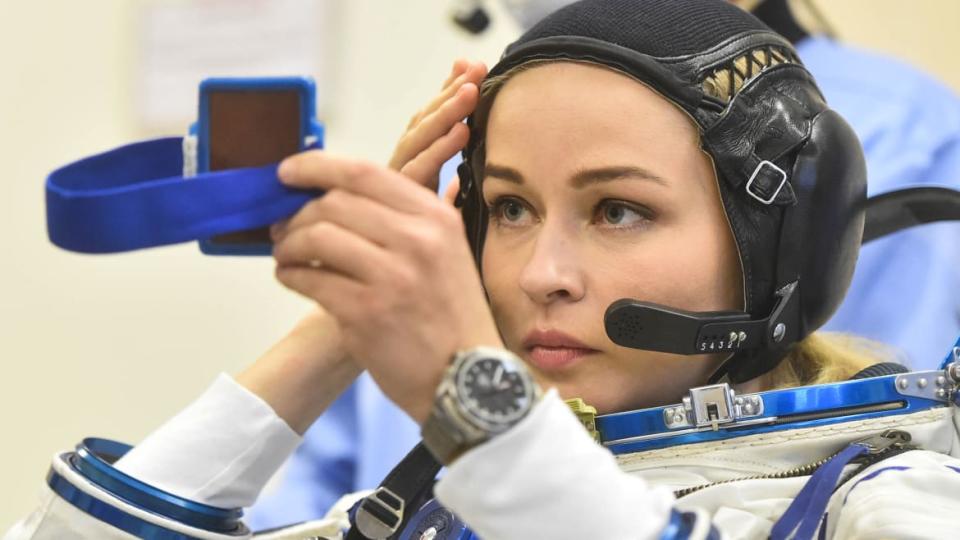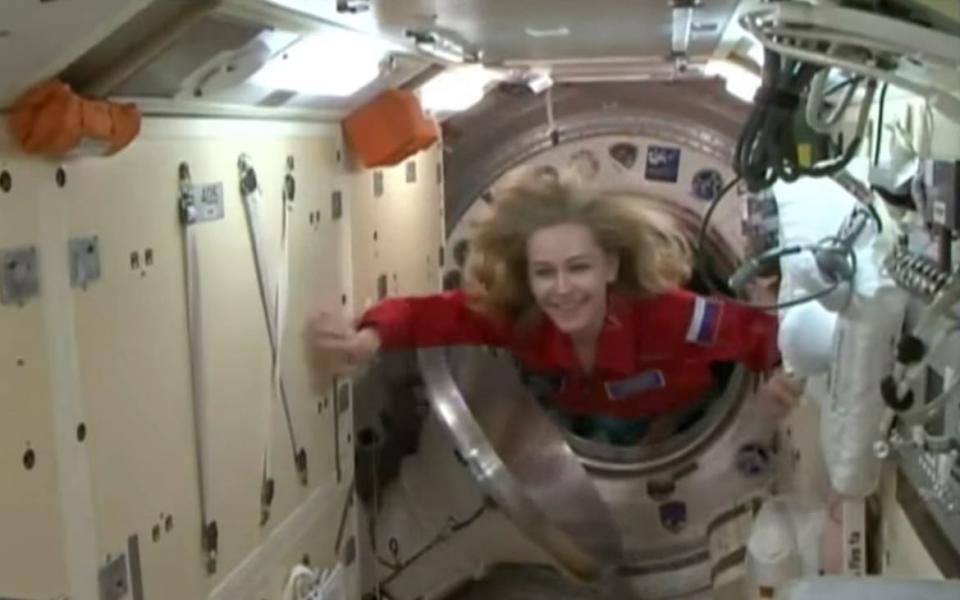Making a Movie Is Hard. Making One in Space Is Insane.

On Oct. 5, a Russian Soyuz spacecraft flew into space with three people on board and docked with the International Space Station a few hours later. The crew’s mission: principal photography on the first fictional feature film shot in space.
That’s right—the point of this trip was not to enable new scientific research or a cutting edge demo of new technologies, as astronauts normally do in space. Along with cosmonaut Anton Shkaplerov, the Russian crew included movie director Klim Shipenko and actress Yulia Peresild. The latter two will spend a total of 12 days aboard ISS gathering footage for The Challenge, a movie about a surgeon sent to the space station to treat a cosmonaut in orbit. It’s the first time in history scenes are being shot for a feature film in space. And it certainly won’t be the last time. The entertainment industry has finally made it to space, and it plans to stay—despite all the challenges to space travel.
Russian Film Crew Beats Tom Cruise to Shoot First Movie at International Space Station
The technological and economic barriers to reaching orbit are so staggering that even 60 years after Yuri Gagarin became the first human being to leave Earth, space has largely remained the domain of government-run space agencies. For decades, the only people going up into space were astronauts and cosmonauts who spent years training at state-of-the-art facilities run by institutions like NASA. Occasionally an extremely wealthy guy would buy his way onto a short mission.
Recent advances in technology, driven by companies like SpaceX in partnership with those government agencies, have lowered those barriers substantially. In June of 2019, NASA announced its intent to open the International Space Station to commercial ventures, as it focuses on deep space missions to the moon and Mars. In addition to the continued scientific missions on ISS, this opened opportunities for private companies to engage in ventures like space tourism and entertainment.
In May of last year, just before the first successful crewed launch of SpaceX’s Crew Dragon spacecraft, news broke that Tom Cruise was in talks with NASA and SpaceX to film a feature aboard ISS. A new space race had begun—not to land on the Moon, but to bring space to the silver screen. Russia’s space agency rose to the challenge, in an effort to remind the world they are still a powerful force in global space operations.
The race for the first feature film shot in space is over before most of us realized it had begun, but it’s only the latest step in a growing relationship between space exploration and entertainment. Low-earth orbit has been the setting for YouTube videos, press briefings, social media posts from orbiting astronauts, IMAX movies—and at least one viral music video.
Former astronaut Chris Hadfield, who just published his own new sci-fi novel entitled The Apollo Murders, spent a total of 166 days in space across three missions to MIR and the ISS, and is no stranger to being behind or in front of a floating camera. As a trained IMAX cameraman, he helped make Mission to MIR and Space Station 3D. He also recorded and filmed a cover of David Bowie’s Space Oddity during his tenure as commander of ISS and knows better than most anyone the challenges behind living and working in space—let alone making art up there.
Once aboard the ISS, the needs of a commercial mission must be balanced with the existing needs of the station. That means at least some of the ongoing scientific work needs to be put on hold. “When we have someone visiting, someone needs to be assigned to take care of them. They need a handler, just like anybody visiting a movie set,” Hadfield told The Daily Beast. “So, if you have a full-time handler for the visitors, then that handler is not contributing to science aboard the space station.”
Hadfield went on to clarify that the space station is not just for science, it’s also for human inspiration, and the station cannot exist outside of humanity at-large. Laboratories, even space-based ones, need funding and public awareness, something blockbuster movies could bring in a way other outreach efforts might not.
Technologically speaking, spaceships are not the friendliest locales for filming. Hadfield likened it to trying to make a movie in the back of a city bus that never stops moving. There are countless machines, fans, pumps, toilets, carbon-dioxide filters, and experiments which can’t be turned off. There’s no such thing as calling quiet on the set.
The closest thing to quiet on the ISS, said Hadfield, is inside sleep berths, with the door closed and the fan turned down to its lowest setting—no one can turn the fan off entirely or they risk suffocation from their own exhalations. Even then, there are alarms and calls from various mission control centers around the world, none of which are going to hold their call just because there’s a scene being shot.
Lighting is another challenge entirely. “You’re going five miles a second, so the angle between you and the sun and the Earth, it’s as if an entire day is accelerated into 45 minutes,” said Hadfield. “Imagine what that would do to your shadows and lighting intensity and everything else. The lighting inside is awful, because it’s just little fluorescent lights. No one films a movie under fluorescent tube lights because it looks like a dentist’s office.”

Yulia Peresild entering the ISS after docking on October 5, 2021.
Even if you can manage the ambient sounds of the station and the poor lighting, your camera is at constant risk of damage by the high levels of radiation and cosmic particles zipping through space. Classic film only lasts a short time in the canister. Taking film into space is similar to putting it through an X-ray machine.
Even modern cameras take damage just from spending time in space. “The sensor in the back of the camera that allows it to record regularly gets hit by high-energy protons coming from our sun or other stars. So, even a digital camera has a fixed life in the station’s high-radiation environment,” Hadfield said.
The protons hit the sensor in the camera and kill pixels where they strike. Given enough time, any images taken will bear a signature swiss cheese imprint. It’s significant enough that the camera used to take a particular space-based photo can be identified by the pattern of dead pixels.
Crafting a movie under those conditions in only 12 days is a tall order, and Shipenko and Peresild have their work cut out for them. Like any new environment or piece of technology, there will be lessons learned with each outing, but Hadfield is hopeful, saying “We’ll see what the future brings. It’s all got to be balanced amongst everything else that’s going on. It will be one more thing, out of the many, that the space station does for us.”
Shipenko and Peresild return to Earth on Oct. 17, and regardless of how the movie turns out, they’ll have made history. From Jules Verne and H.G. Wells, to Gene Roddenberry and George Lucas, people have been putting space in stories. Now, at last, they’ll be putting stories in space.
Get our top stories in your inbox every day. Sign up now!
Daily Beast Membership: Beast Inside goes deeper on the stories that matter to you. Learn more.

 Yahoo Finance
Yahoo Finance 